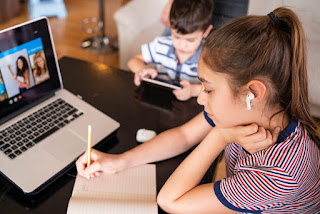Why have a Professional Learning Network as a School Librarian?
Technology has advanced for many educators over the years. As a future school librarian, I am constantly learning innovative technology, but intimidated by what it has to offer me to help in building my skills beyond what I have learned in my education so far and through my work experiences. In any professional learning, we all must step out of our comfort zone to learn. Everyone learns differently and must do what works for them. Sure, we have professional development in our field, but is that enough or do we want to learn something that is not recommended by others or required to do? How can we educate students creatively if we use the same tools? This is where a professional learning network or PLN (Professional Learning Networks) comes in.
What is PLN?
What is a professional learning network? A professional learning network or personal learning network is a "tool that uses social media and technology to collect, communicate, collaborate, and create by connecting with others who have shared interests, ideas, or resources" (Whitby, 2013). Every person that an individual connects to on social media has a piece of information that relates to their field, and this can be accessed anywhere. The purpose of professional learning networks is "personalized learning" (TeachThought Staff, 2018). In other words, this is learning that is not controlled by anyone, but it is the individual that determines what is needed based on their goals of learning. Here is an example of what a professional learning network may look like, since they take many forms:
Image Source: Author
Benefits of PLN
Professional learning networks are important and beneficial to the profession. First, they can provide access to different perspectives and experiences (Mukluka, 2023). Professionals, whether teachers or school librarians, face quite a bit in their daily lives (Poth, 2023). Professional learning networks can allow individuals to bounce ideas off other professionals to get insight to help guide them on how they can change what they do and receive encouragement. As I think of this from a school librarian perspective, the learning networks also expose librarians to added resources to help with instruction, library management, and even recommendations for books to add into an existing collection. Professional learning networks have many benefits to help anyone in any profession advance them in their careers and provide them with an identity among professionals.
Where to Begin
The first task to begin to search for your professional learning network is to identify your learning goals and interests. As I said in my example above, learning networks come in many forms. Social media platforms such as Twitter and Facebook are some examples of platforms that provide many options. What is so great about social media if you are not a social media fan? Well, you can connect with people near and far (MacFarlane, 2013). It is not recommended to join any network, but to take time to examine what is out there and then participate. Join in the conversation and follow others once you are ready.
My concept map above shows the potential routes one can take to grow their network. Do not just limit yourself to online networks but look around your community as well as right where you work at. We grow by looking all around us and staying open minded. Here are other routes one can try:
Not everyone's professional learning network is the same, but an individual determines what they need based on their goals.
My PLN
My professional learning network is a work in progress as I am trying to figure out what my own needs are that will work on my future goal of becoming a future school librarian. I do have my colleagues at work. Most are teachers, but I feel like that is important as my position will require me to collaborate with teachers. I have begun to look for groups to network with online through Facebook, but slowly exploring other social media to see what will work. Maybe I will even take that next step and explore avenues that are out of my comfort zone.
 |
| Image Source: https://educationnorthwest.org |
Sources:
TeachThought Staff. (2018, October 1). What is a Personal Learning Network? https://www.teachthought.com/pedagogy/what-is-a-personal-learning-network/
Whitby, T. (2013, November 18). How do I get a PLN? Edutopia. https://www.edutopia.org/blog/how-do-i-get-a-pln-tom-whitby
.png)

Comments
Post a Comment